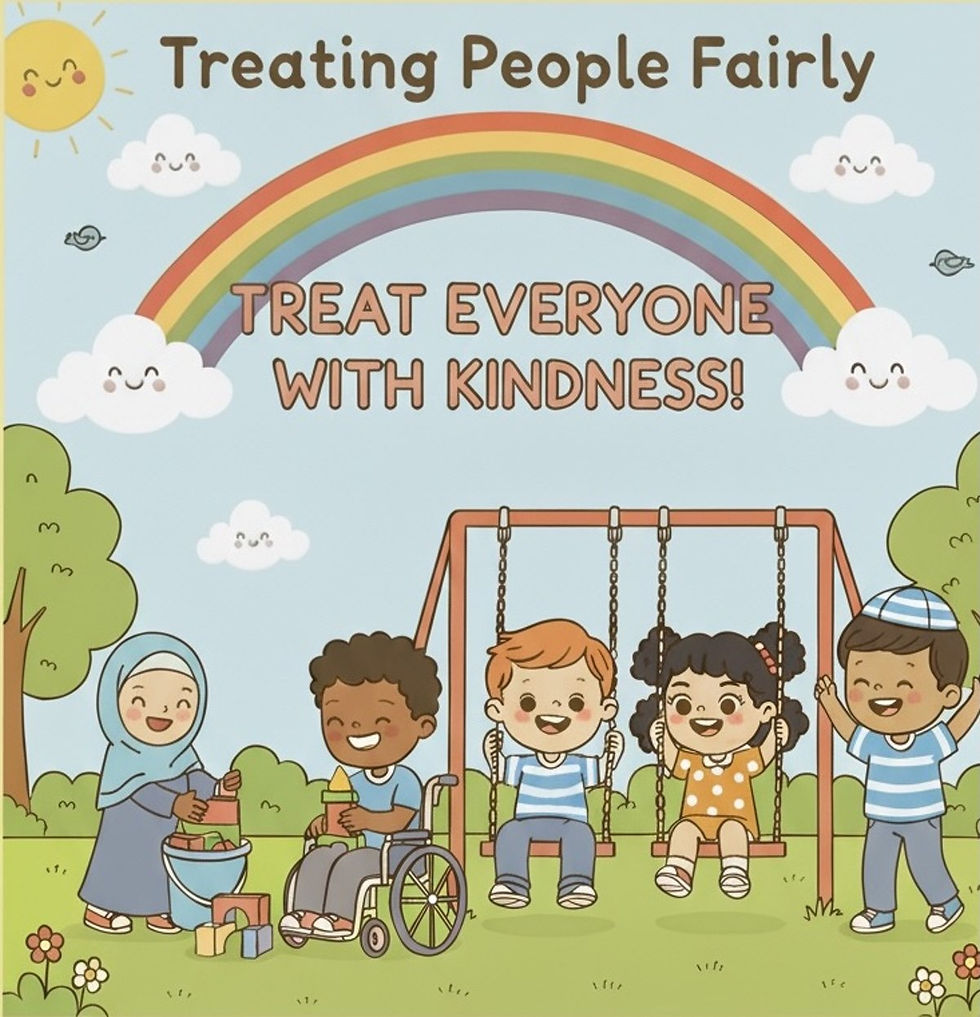Treating People Fairly
- Balance Learning Resources

- Oct 28
- 3 min read
Updated: Dec 17
Grade Level: K-2
Duration of video 1: 1 minute, 38 seconds
Duration of video 2: 2 minutes, 45 seconds
Duration of video 3: 2 minutes, 2 seconds
Themes: Kindness • Inclusion • Safety • Honesty • Sharing • Using One's voice • Simple problem-solving • Empathy • Building a caring classroom community • Practicing courage

Description:
Students learn what fair and unfair look like through brief, age‑appropriate clips (e.g., Daniel Tiger, Sesame Street, and Bluey). Using a kid‑friendly Justice Checklist (kind • safe • true • everyone included • solves the problem), children identify an unfair moment, propose a fair fix, and practice it with quick role‑plays. The focus is on words and actions that help everyone feel safe and belong.
Video 1: Daniel Tiger's Neighborhood | "When I See Something that Isn't Fair" Song | PBS KIDS (1:38)
Video 2: Elmo Plays Hide and Seek with Brett Goldstein and Grover | Sesame Street Season 53 (2:45)
Video 3: Bluey Ice Cream Video (2:02)
Lesson Plan:
🎯 OBJECTIVES (SWBAT):
Define “fair” vs. “unfair” in child‑friendly language.
Spot unfair situations and suggest a fair fix (safe words/actions).
Choose kindness, truth, turn‑taking, and inclusion.
🧰 MATERIALS:
Video 1: Daniel Tiger's Neighborhood | "When I See Something that Isn't Fair" Song | PBS KIDS (1:38)
Video 2: Elmo Plays Hide and Seek with Brett Goldstein and Grover | Sesame Street Season 53 (2:45)
Video 3: Bluey Ice Cream Video (2:02)
Chart paper/markers (to make a 3-columned t-chart)
Student Worksheet 1: Fairness Checklist (Printed for each student or digital copy)
Student Worksheet 2: Scenario Cards (Printed for each student or digital copy)
📋 LESSON FLOW
Warm-up: Write the word “FAIR” on the board.
Say: “Fair means everyone gets what they need to be safe and included.” Ask students to give examples of when something is “fair.”
Say: “There are certain ways we know that something is fair.” Hand out Student Worksheet 1: Fairness Checklist (Either Printed for each student or a digital copy).
Read and discuss with the class: Student Worksheet 1: Fairness Checklist
Tell the students: We will be watching three videos today, and then we will be using the checklist to decide what is just/what is fair in each of the videos.
Draw a three-columned t-chart on the board:
Title the chart “Fairness in Videos.”
Each column will refer to a different video.
After showing each video, ask students to tell you which fair behaviors from Student Worksheet 1: Fairness Checklist they saw in each video. Write students’ responses in the t-chart.
Watch & Talk:
Play Video 1: Daniel Tiger's Neighborhood | "When I See Something that Isn't Fair" Song | PBS KIDS (1:38) Ask: “What was unfair? What did Daniel do to help?” (Add students’ answers to column one of your “Fairness in Videos” t-chart.)
Play Video 2: Elmo Plays Hide and Seek with Brett Goldstein and Grover | Sesame Street Season 53 (2:45). Ask: What fair actions did the characters do on the playground? (Add students’ answers to column two of your “Fairness in Videos” t-chart).
Play Video 3: Bluey Ice Cream Video (2:02) Ask: What fair actions did the characters do in this video? (Add students’ answers to column three of your “Fairness in Videos” t-chart.)
Practice Being “Fair:"
In trios, give each group Student Worksheet 2: Scenario Cards.
Directions to students: “Draw a fair action to fix each situation using our Fairness Checklist.”
Invite each group to role‑play a fair resolution to one of the scenarios on Student Worksheet 2: Scenario Cards and have the rest of the class name the Fairness Checklist item(s) they used.
Close
Exit drawing: “Draw one fair action you can do today.” (Hang these drawings up on the wall of the classroom.)
Classroom Signage to Remember and Apply Lesson:
Teacher can make a poster of the “Fairness Checklist” from Student Worksheet 1: Fairness Checklist, have students sign and/or decorate it, and hang it up in the room.
Post on the wall the “Fairness in Videos” t-chart you created with students during post-video discussions.
Post students' artwork from Student Worksheet 2: Scenario Cards on the wall.
Assessment:
Observe role‑plays; collect drawings for “uses kind words / safe actions / shares / invites others.”
© 2025-2026
All materials on this website are available for educational use under Creative Commons License CC BY-NC-ND 4.0. Educators may download and share the content with attribution, for non-commercial use and instructional purposes, and without modification. Embedding any materials within any website-whether educational, institutional, public, or private-is prohibited without prior written consent of Balanced Learning Resources. Unauthorized embedding or redistribution may violate copyright and licensing terms.

